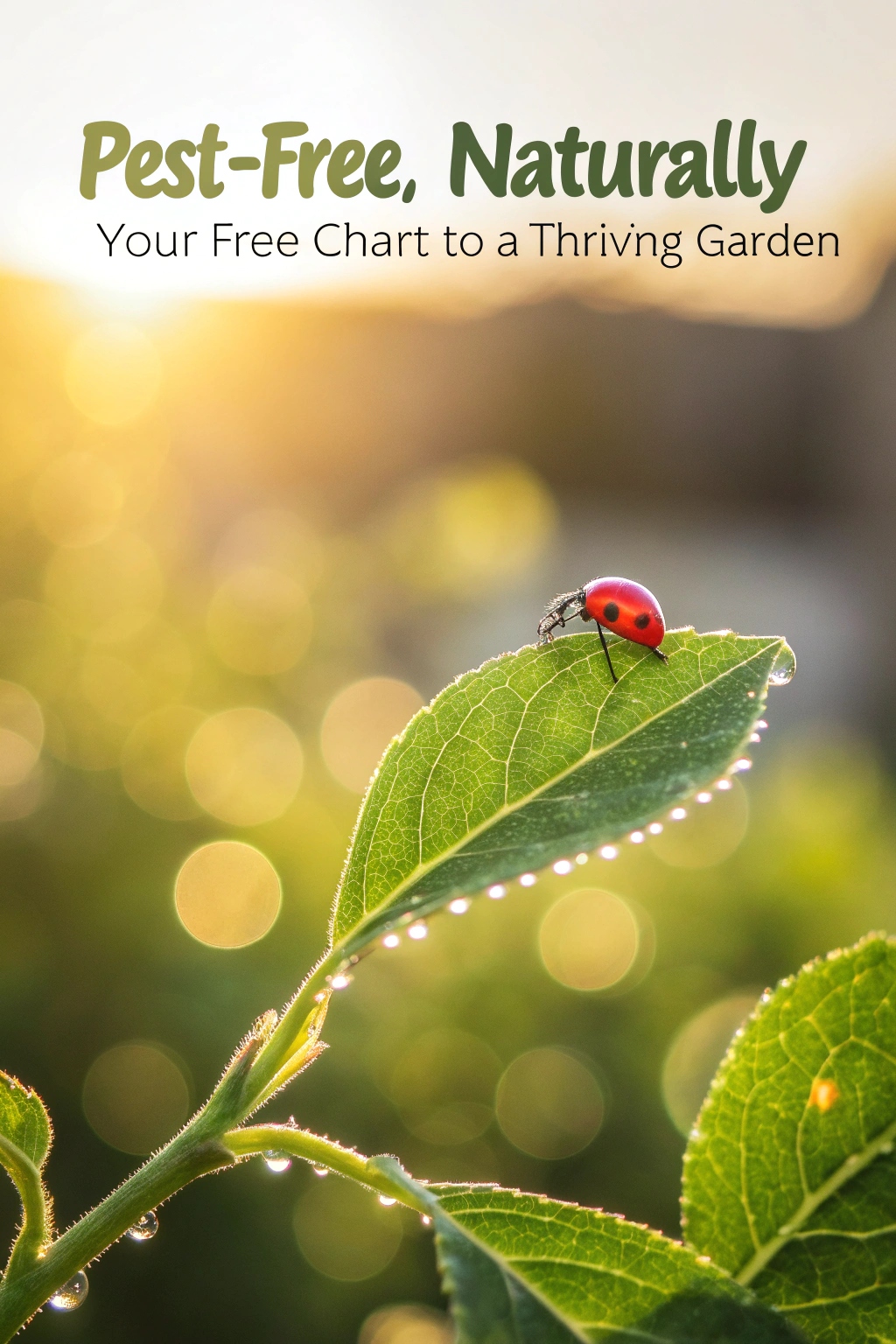Did you know a single zucchini plant can grow 10 pounds of squash? It’s true!
Even if your garden is small, you can still grow lots of zucchini. Use raised beds to save space and help roots grow better. Try planting zucchini with other crops like tomatoes or beans to make the most of your garden. This helps keep pests away and uses sunlight wisely. With smart tips, you’ll have zucchinis all summer long.
Growing zucchini is fun and easy. Start by choosing the right spot with lots of sun. Add compost to the soil for strong plants.
Pick zucchinis when they’re small to keep them growing. Use containers or vertical space if you have no yard. These tricks make big harvests possible. Watch your garden fill with green squash!
Choosing the Right Zucchini Varieties
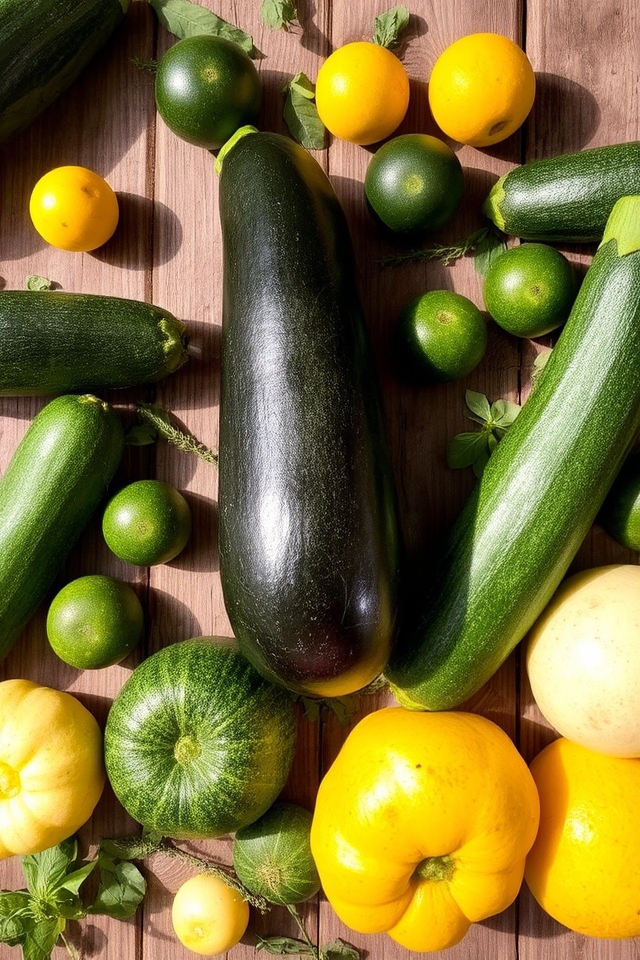
When selecting the right zucchini varieties for your garden, consider factors such as climate, space, and intended use. Popular varieties include the classic ‘Black Beauty’ for its rich flavor, and ‘Yellow Crookneck’ for a unique appearance. For limited space, try compact types like ‘Pattypan’ or ‘Zucchini Eight Ball,’ which grow well in containers. Additionally, explore heirloom options for diverse flavors and textures, ensuring a bountiful and vibrant zucchini harvest.
Best Planting Locations for Zucchini
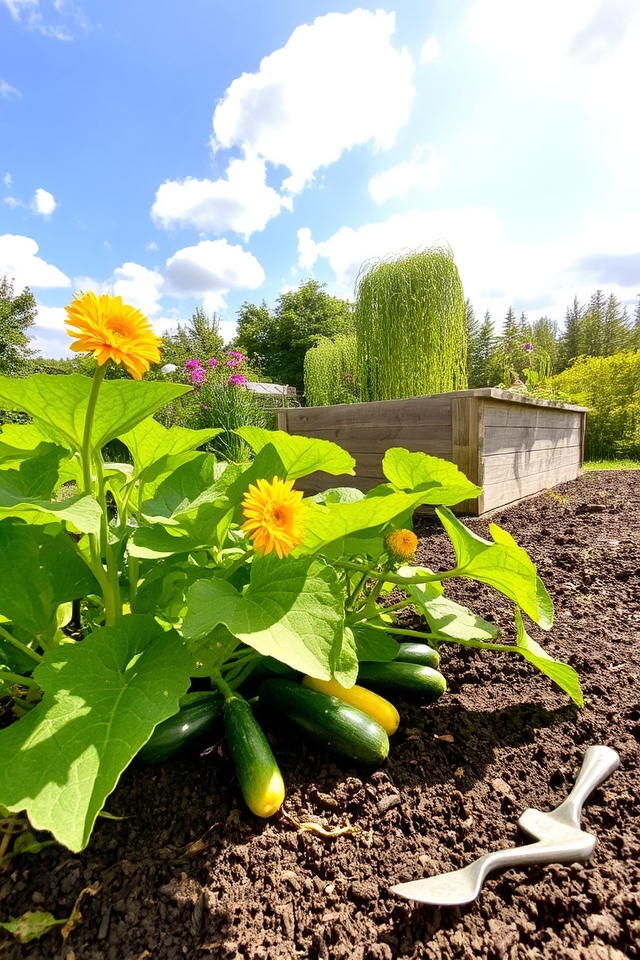
When selecting the best planting locations for zucchini, aim for spots that receive full sun for at least 6-8 hours a day, as this helps produce healthy, vigorous plants. Choose well-drained, nutrient-rich soil to promote growth, and guarantee adequate air circulation to prevent disease. Raised beds or garden plots with good exposure to warmth are ideal. Additionally, consider a location with space for sprawling vines, as zucchini plants can spread considerably during the growing season.
Companion Planting for Healthy Zucchini
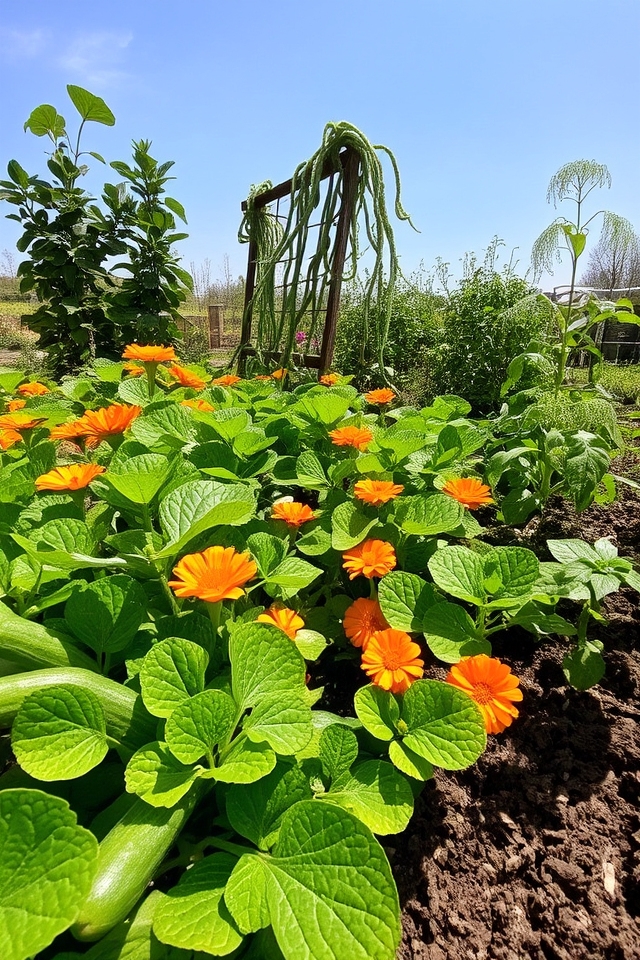
Companion planting is a great strategy to enhance the growth and health of your zucchini plants. Pairing zucchini with plants such as marigolds, which deter pests, or beans, which fix nitrogen in the soil, can create a thriving garden ecosystem. Additionally, planting herbs like basil or dill can attract beneficial insects that pollinate and protect zucchini from harmful pests. By choosing the right companions, you can optimize space and boost yields while minimizing the need for chemical interventions.
Optimal Soil Preparation Techniques
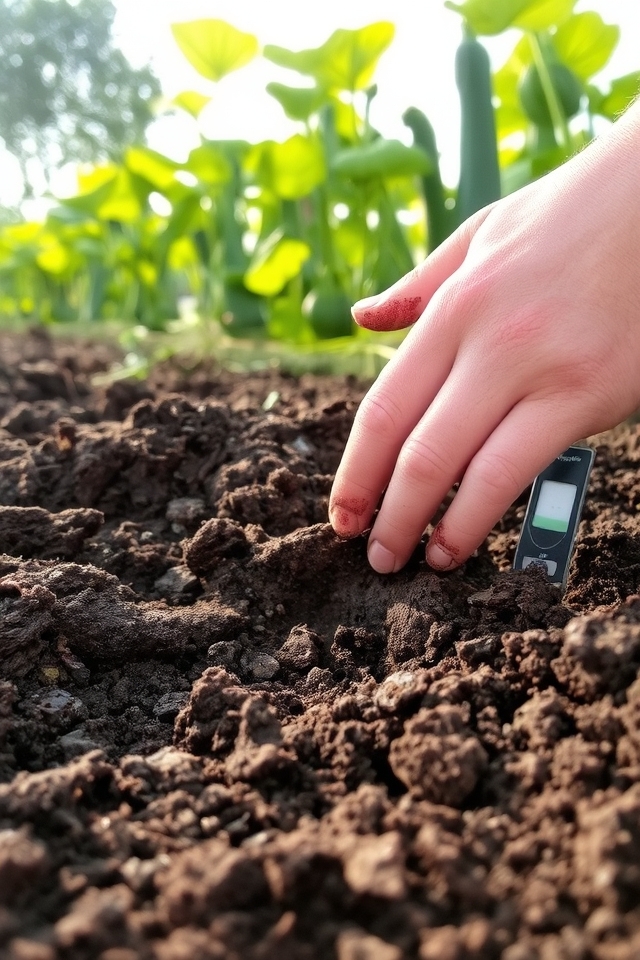
To cultivate healthy zucchini plants, ideal soil preparation is essential. Start with well-draining soil rich in organic matter, such as compost or aged manure, which enhances fertility and moisture retention. Test the soil pH; zucchini thrives in a range of 6.0 to 7.0. Till the soil to a depth of 12 inches, breaking up clumps and incorporating organic amendments. This creates a perfect environment for root development and guarantees robust growth throughout the growing season.
Effective Watering Strategies
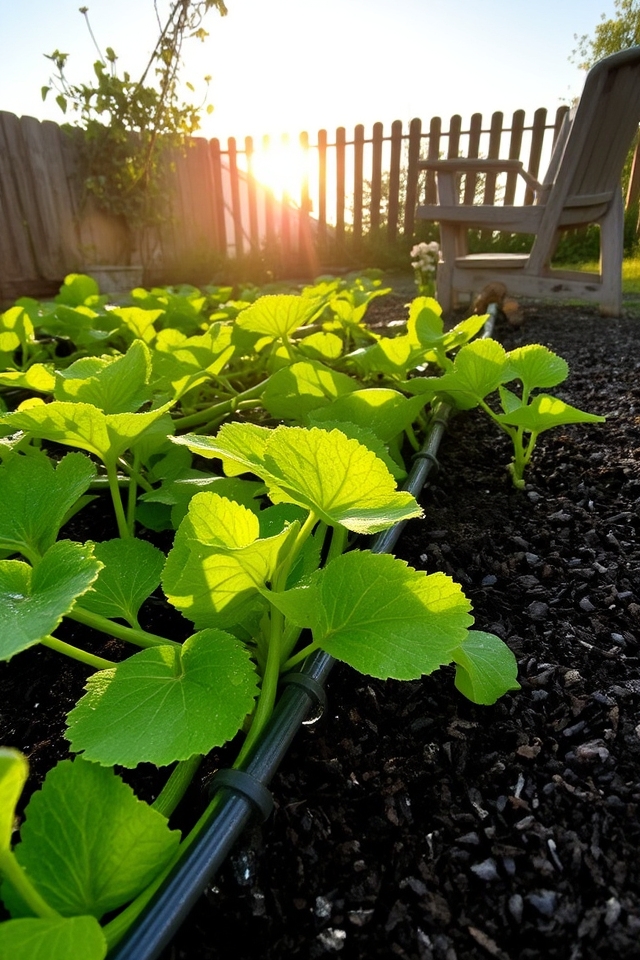
Effective watering strategies are essential for nurturing healthy zucchini plants. Aim for deep, infrequent watering to encourage robust root growth. Early morning is the best time to water, allowing leaves to dry out and reducing the risk of fungal diseases. Use a drip irrigation system or soaker hoses to deliver moisture directly to the soil, minimizing evaporation and maximizing efficiency. Mulching around the plants can also help retain soil moisture and regulate temperature.
Utilizing Raised Garden Beds
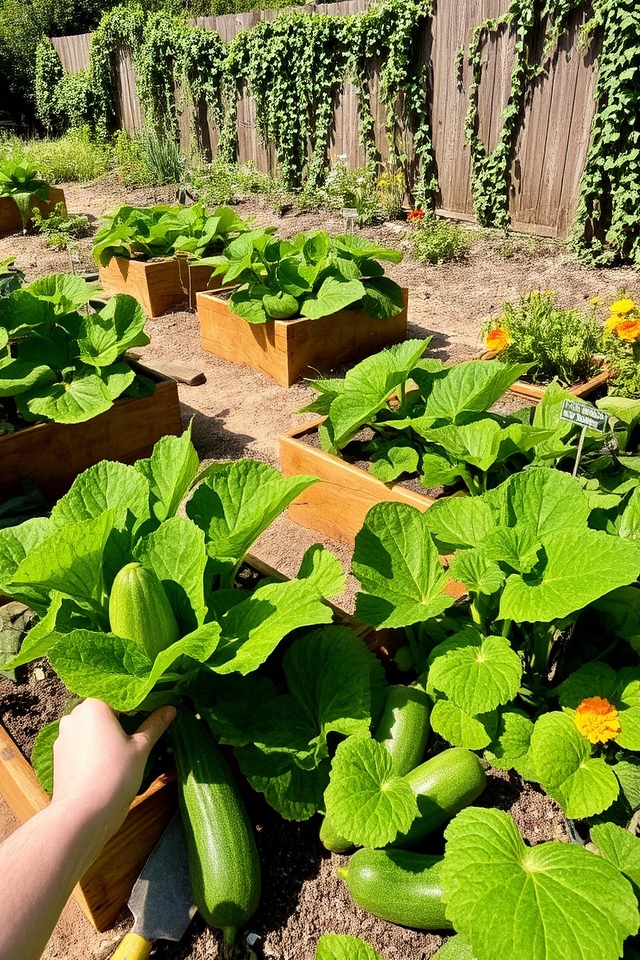
Using raised garden beds for zucchini cultivation offers several benefits, including improved drainage, better soil quality, and easier access for planting and harvesting. These elevated structures also provide better pest control and can extend the growing season by warming the soil faster in spring. Additionally, raised beds allow for organized planting layouts, making it easier to manage companion planting techniques. With the right positioning and care, raised garden beds can greatly enhance zucchini yield and overall garden productivity.
Vertical Gardening for Space Efficiency

Vertical gardening is an innovative solution for maximizing space in your zucchini garden, especially when garden space is limited. By utilizing trellises, stakes, or hanging planters, you can grow zucchini plants upwards rather than outwards. This method not only saves valuable ground space but also improves air circulation and sunlight exposure for the plants. Additionally, vertical gardening can reduce pest infestations and make harvesting easier, allowing for a more productive and efficient gardening experience.
Container Gardening With Zucchini
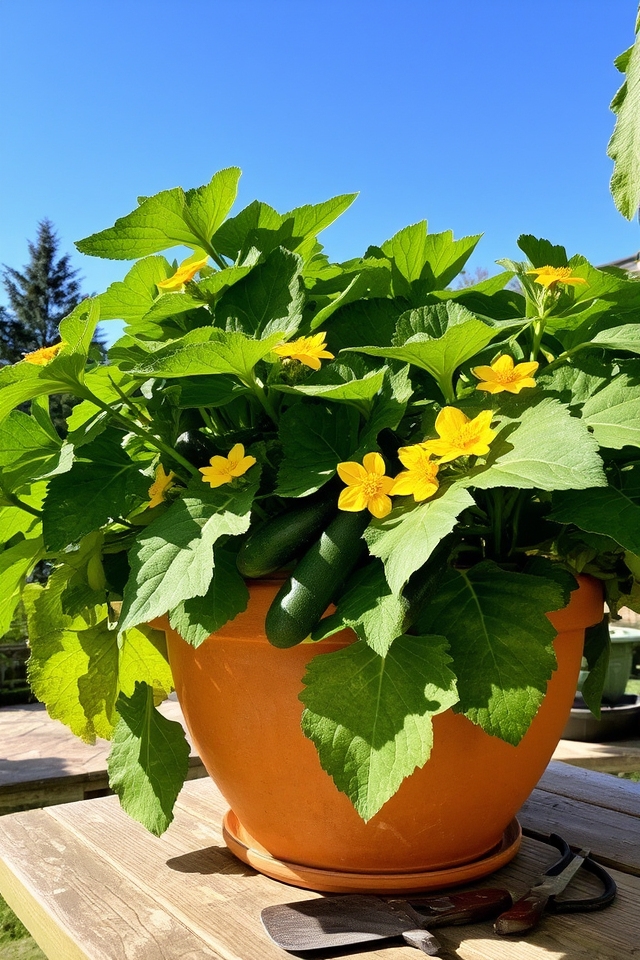
Container gardening with zucchini is an excellent option for those with limited space or poor soil conditions. Choose a large container (at least 5 gallons) to accommodate zucchini’s sprawling growth. Use high-quality potting soil rich in nutrients and guarantee the container has proper drainage. Position it in a sunny spot, as zucchini thrives in full sunlight. Regular watering and fertilization will promote healthy growth, allowing you to enjoy fresh zucchinis even in small spaces.
Maximizing Sun Exposure
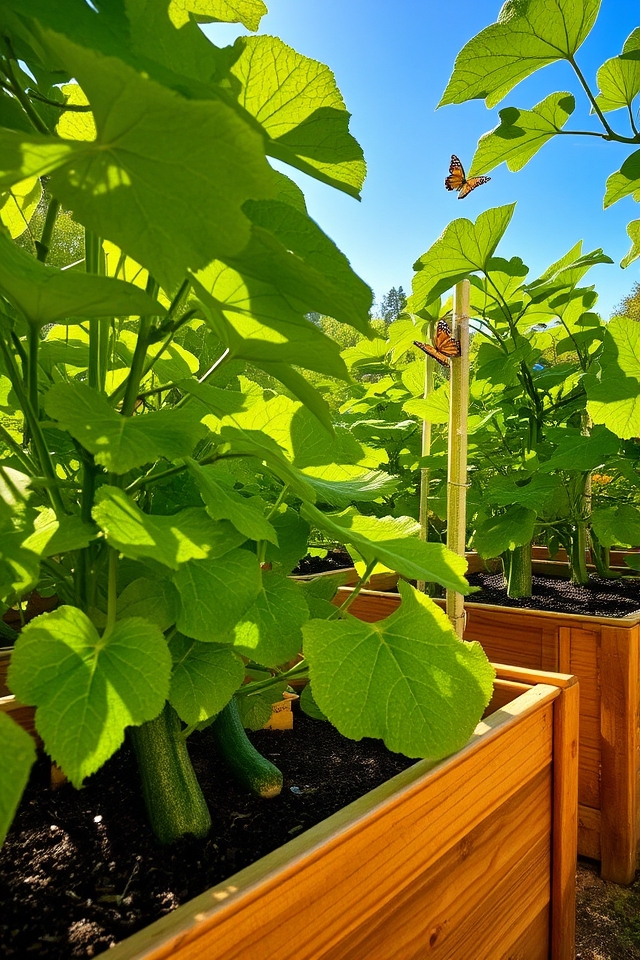
Maximizing sun exposure is essential for growing healthy zucchinis, as they thrive in full sunlight. When planning your zucchini garden, position your plants to receive at least six to eight hours of direct sunlight daily. Use raised beds or containers to elevate plants and guarantee they aren’t overshadowed by taller crops. Additionally, consider planting your zucchinis on the southern side of your garden to maximize their exposure, allowing them to flourish and yield a bountiful harvest.
Using Trellises for Support
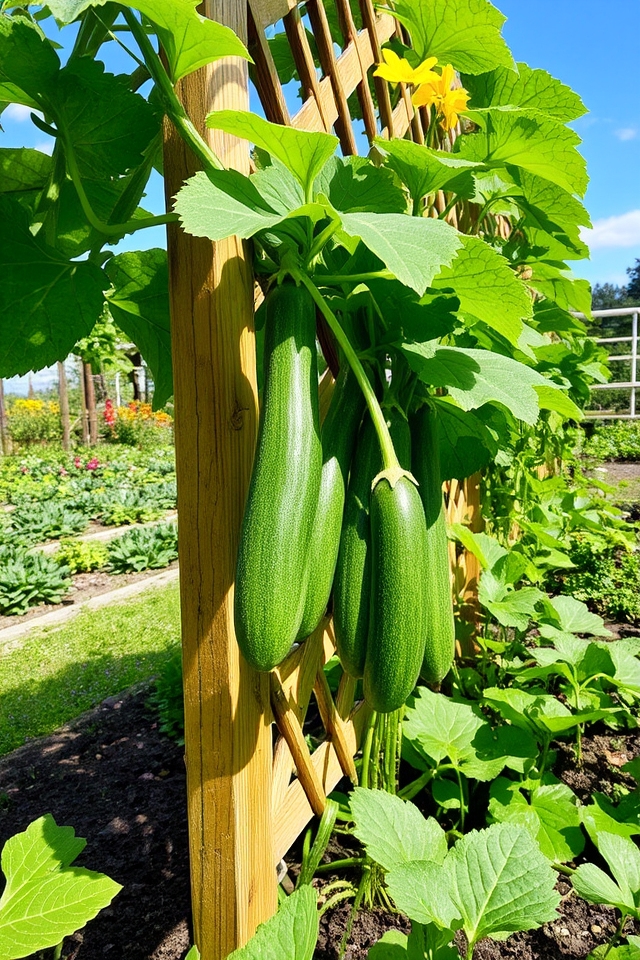
Using trellises for zucchini support can vastly improve your garden’s health and yield. By elevating zucchini plants off the ground, trellises allow for better air circulation and sunlight exposure, reducing the risk of disease and pest infestations. Additionally, vertical growing saves space and makes harvesting easier. Choose a sturdy trellis, such as a wooden frame or metal grid, and guide the zucchini vines upward for a flourishing and organized garden display.
Crop Rotation for Soil Health
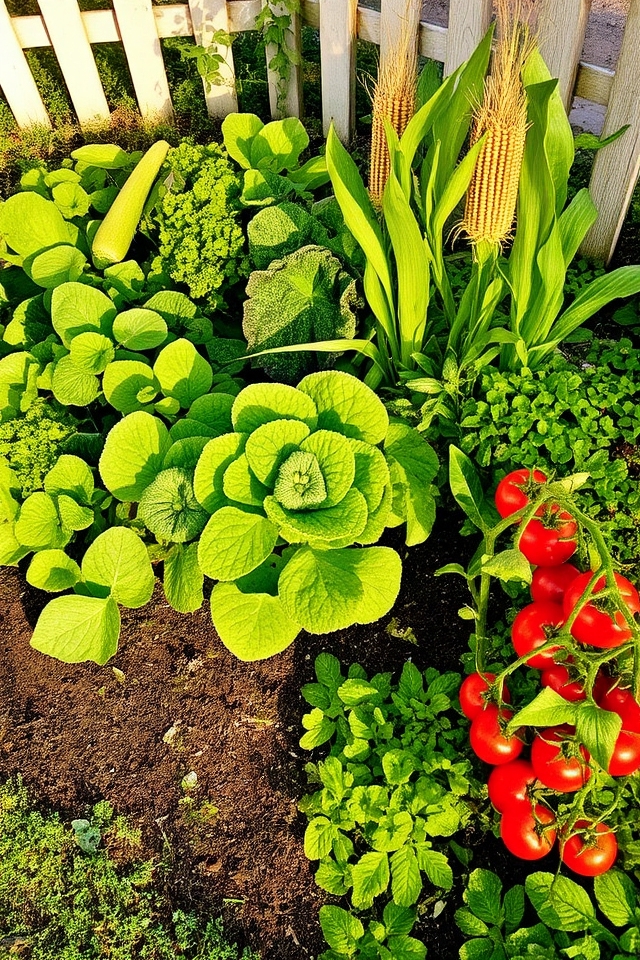
Crop rotation is a crucial practice in maintaining soil health, especially in zucchini gardening. By alternating zucchini with different plant families each growing season, you can reduce the risk of pests and diseases that typically thrive in the same soil. Additionally, rotating crops helps to balance nutrient levels, as different plants utilize varied essential nutrients. This practice contributes to richer soil structure, ultimately leading to healthier plants and a more bountiful harvest.
Organic Pest Control Methods
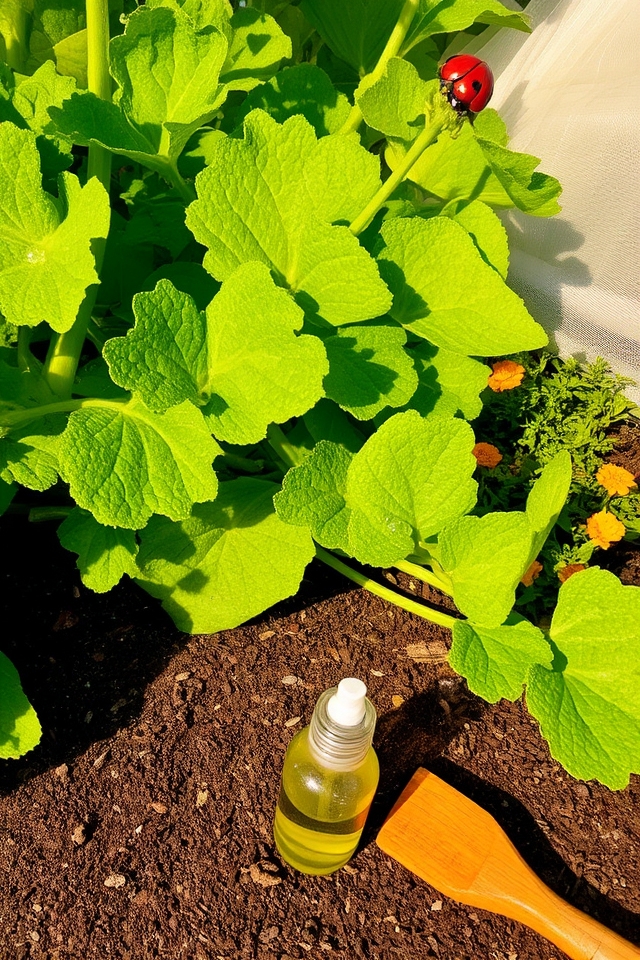
Organic pest control methods are essential for maintaining a healthy zucchini garden without relying on synthetic pesticides. Strategies include introducing beneficial insects like ladybugs and lacewings, which prey on harmful pests. Foil barriers and row covers can protect young plants from infestations. Additionally, natural solutions such as neem oil and insecticidal soap can effectively target pests while remaining safe for the environment. Emphasizing biodiversity and companion planting also helps deter unwanted insects and supports a thriving garden.
Mulching to Retain Moisture
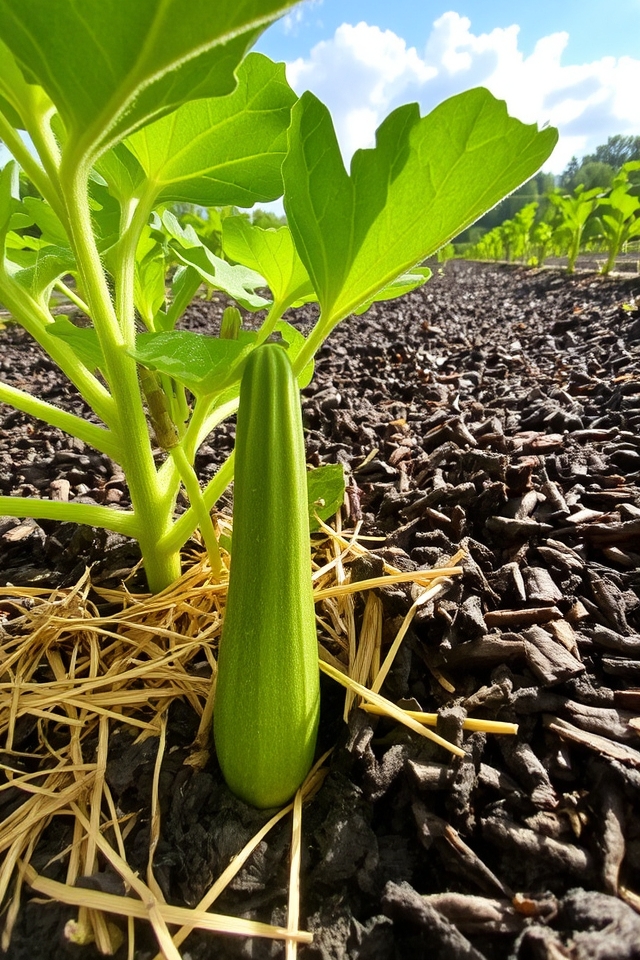
Mulching is an effective technique for retaining moisture in your zucchini garden. By applying a layer of organic materials such as straw, wood chips, or shredded leaves around the base of your plants, you help regulate soil temperature and minimize water evaporation. This not only conserves moisture but also suppresses weeds, allowing your zucchinis to thrive. Regularly replenishing the mulch will guarantee your plants receive consistent hydration, especially during hot summer months.
Fertilizing for a Bountiful Yield
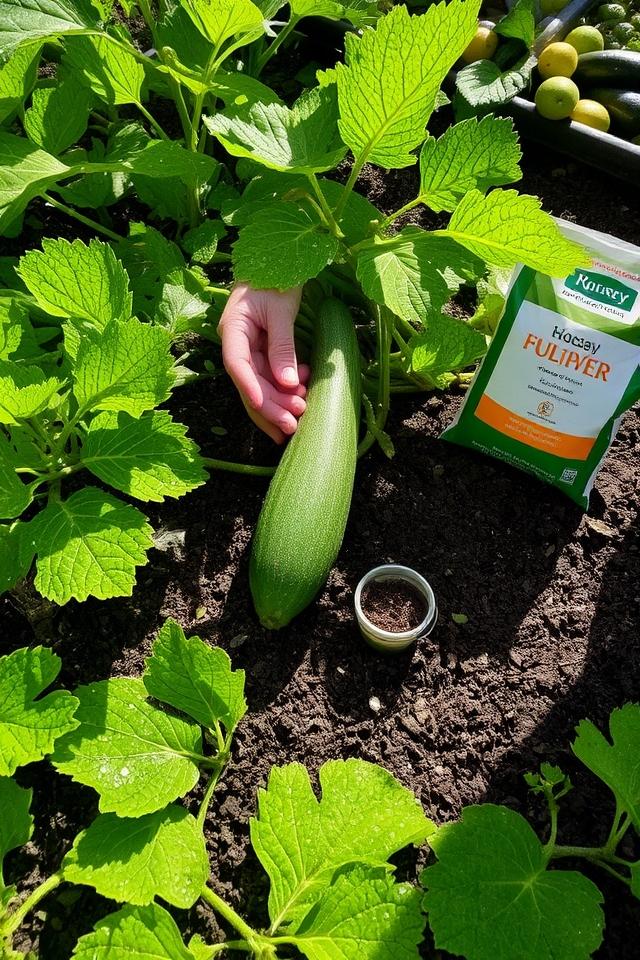
Fertilizing zucchini is essential for a bountiful yield, as these plants thrive on rich nutrients. Start with a balanced fertilizer high in nitrogen to promote leafy growth, particularly during the early stages. As the plants begin to flower, switch to a phosphorus-rich fertilizer to enhance fruit development. Regularly incorporate organic compost or well-rotted manure into the soil for added fertility. Additionally, consider foliar feeding with liquid fertilizers for a quick nutrient boost throughout the growing season.
Pruning Techniques for Better Growth
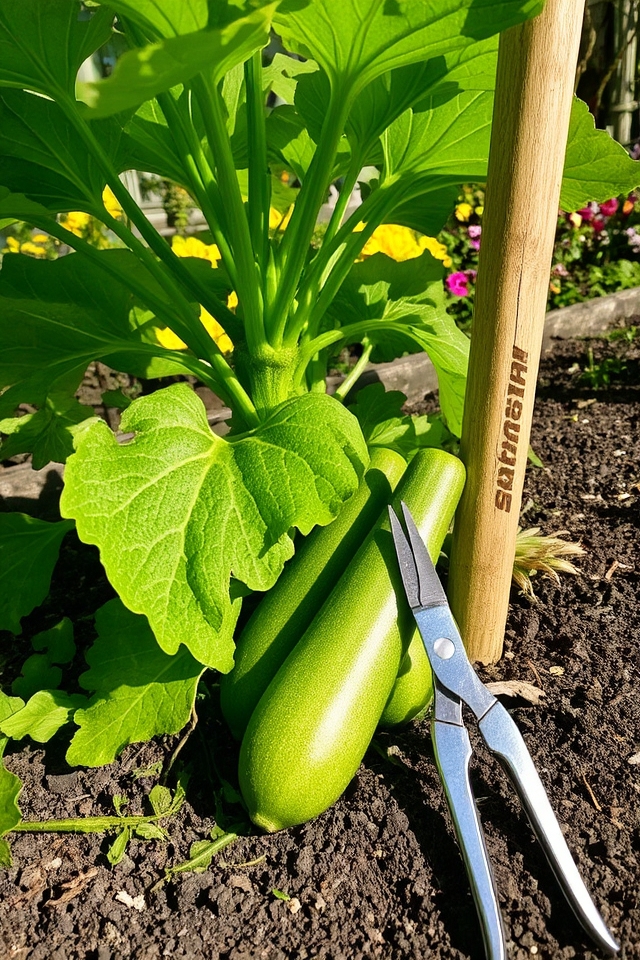
Pruning zucchini plants is essential for promoting better growth and fruit production. By removing dead or yellowing leaves and any congested or crowded stems, you allow improved air circulation and light penetration, which benefits the overall health of the plant. Additionally, selectively trimming excessive leaf growth can redirect the plant’s energy towards producing more blossoms and zucchinis. Aim to prune sparingly, focusing on maintaining a balanced and open structure to encourage robust development.
Timing Your Planting for Continuous Harvests
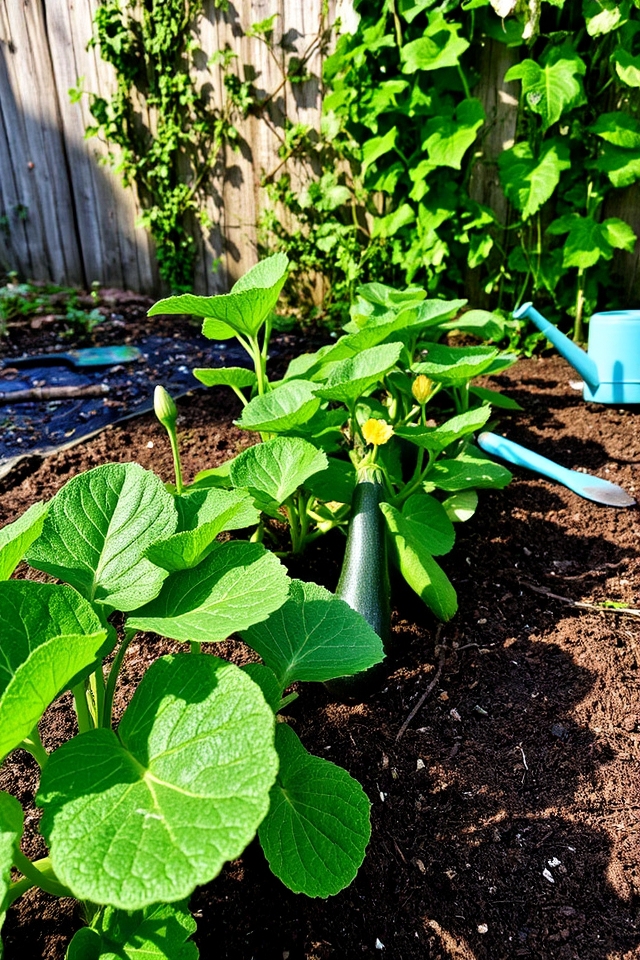
Timing your planting is essential for achieving continuous harvests of zucchini throughout the growing season. Start by planting your first batch indoors or directly in the garden after the last frost date, spaced about 3-4 weeks apart. This staggered approach guarantees that while earlier plants are producing, subsequent batches are maturing, providing a steady supply of fresh zucchini. Additionally, consider planting different varieties at each interval to diversify your harvest and maximize flavors in your recipes.
Intercropping With Fast-Growing Plants
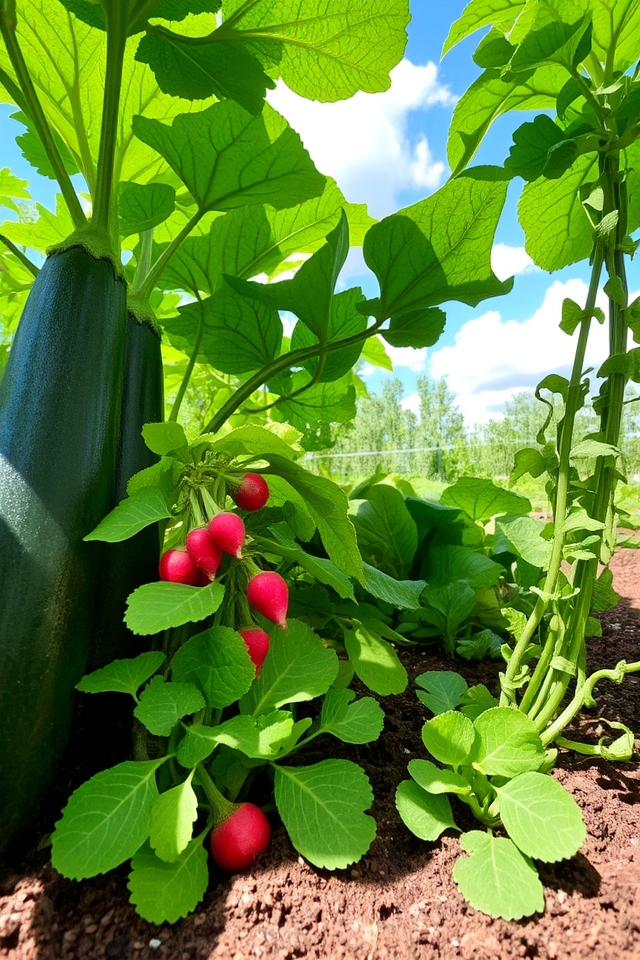
Intercropping zucchini with fast-growing plants is an effective way to maximize garden space and yield. Pairing zucchini with crops like radishes, lettuce, or bush beans allows for efficient use of resources, as the quick-growing plants can be harvested before zucchini plants fully mature. This strategy helps suppress weeds, reduces pests, and improves soil health. Additionally, the diverse plantings create a more vibrant and productive garden ecosystem, making the most of your growing season.
Creative Garden Layout Ideas
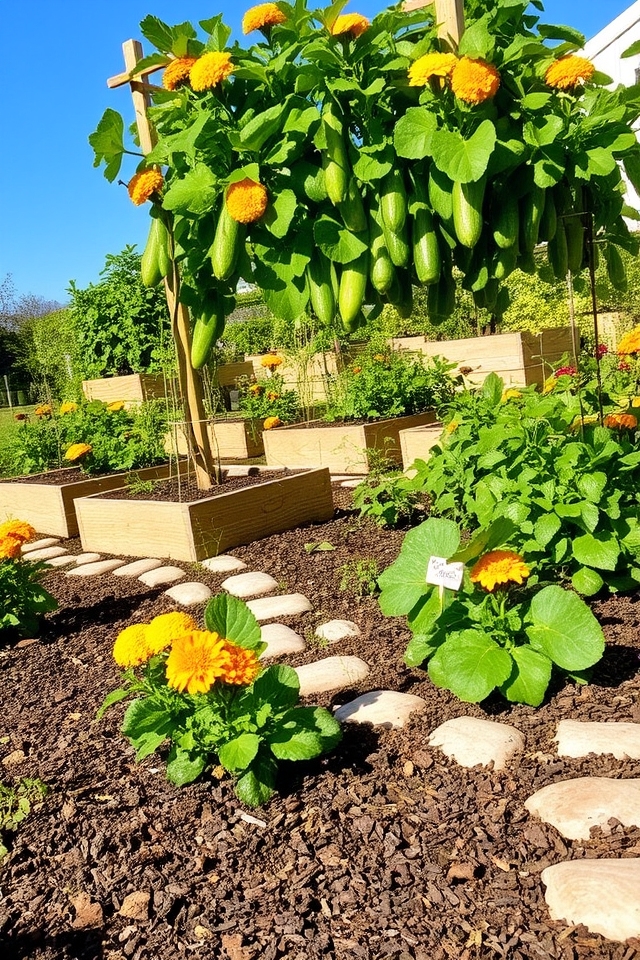
Creative garden layouts can transform your space into a stunning zucchini haven. Consider raised beds with tiered levels to maximize sunlight and accessibility. Plant zucchini alongside companion crops like marigolds or tomatoes to enhance growth and deter pests. Vertical gardening using trellises allows for efficient space utilization, while creating a lush, green backdrop. Incorporate paths with decorative stones or mulch to create defined areas, making your zucchini garden both functional and visually appealing.
Using Hoop Houses for Early Growth
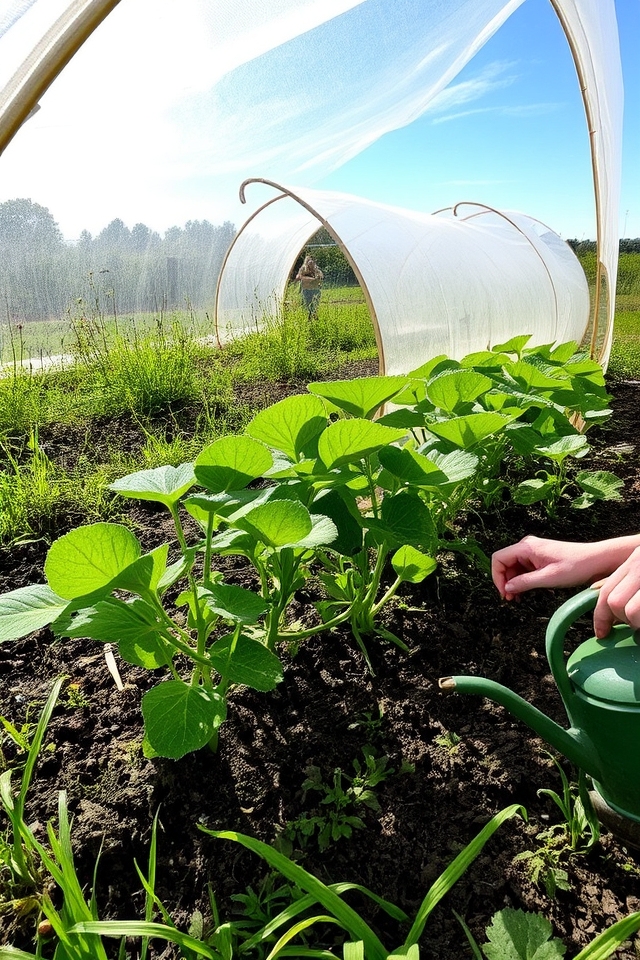
Hoop houses are an excellent solution for extending the growing season of zucchinis. By creating a greenhouse effect, these simple structures trap heat and protect young plants from cold temperatures and harsh weather conditions. Positioning hoop houses over freshly planted zucchini seeds or seedlings allows for earlier growth, ensuring a bountiful harvest. Additionally, they can help control pests and diseases, making them an efficient choice for zucchini gardeners seeking to maximize their yields.
Harvesting Tips for Optimal Flavor
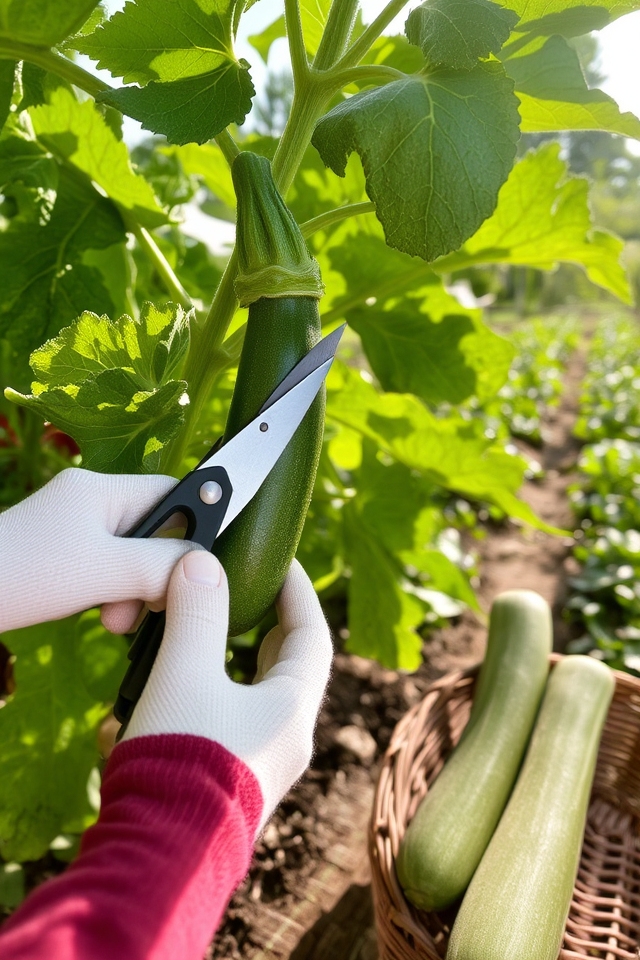
To achieve ideal flavor in your zucchini harvest, timing is key. Harvest zucchinis when they are about 6 to 8 inches long and still tender. This guarantees a sweeter taste and a better texture. Use a sharp knife or garden shears to cut the fruit from the plant, leaving a small stem attached. Harvest in the morning when temperatures are cooler, which helps retain the vegetable’s moisture and flavor. Regular harvesting encourages more production and prevents oversized zucchinis that can become tough and bland.
Preserving Your Zucchini Bounty
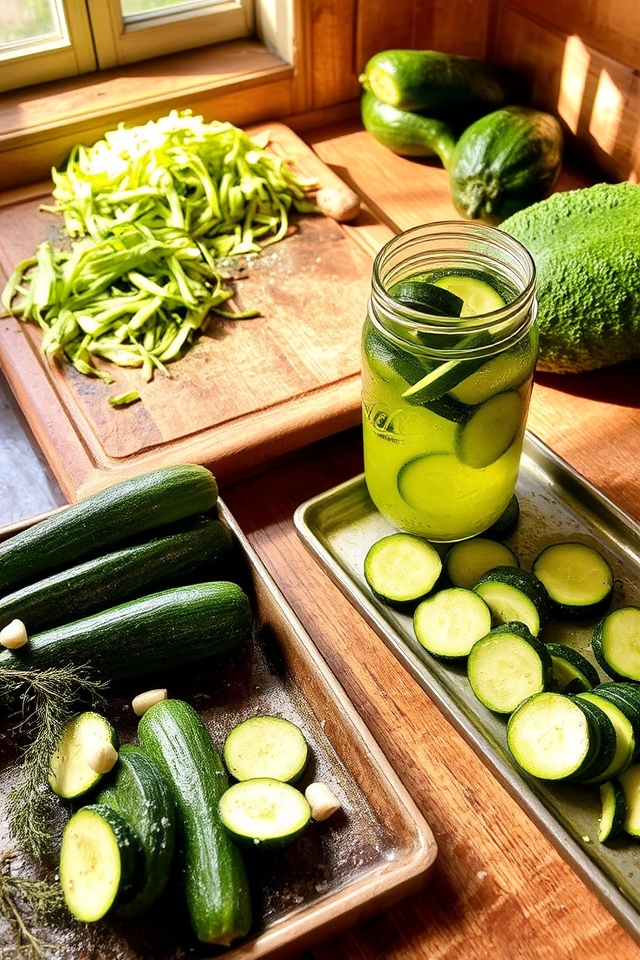
Preserving your zucchini bounty is essential to enjoy this versatile vegetable year-round. You can freeze shredded zucchini, making it perfect for future baking. Another option is to can zucchini pickles, adding a tangy twist to your meals. Additionally, consider drying slices for a crunchy snack or adding to soups. With a variety of preservation methods, you can savor the fresh taste of your garden even during the off-season.
Cooking and Recipe Ideas for Fresh Zucchini
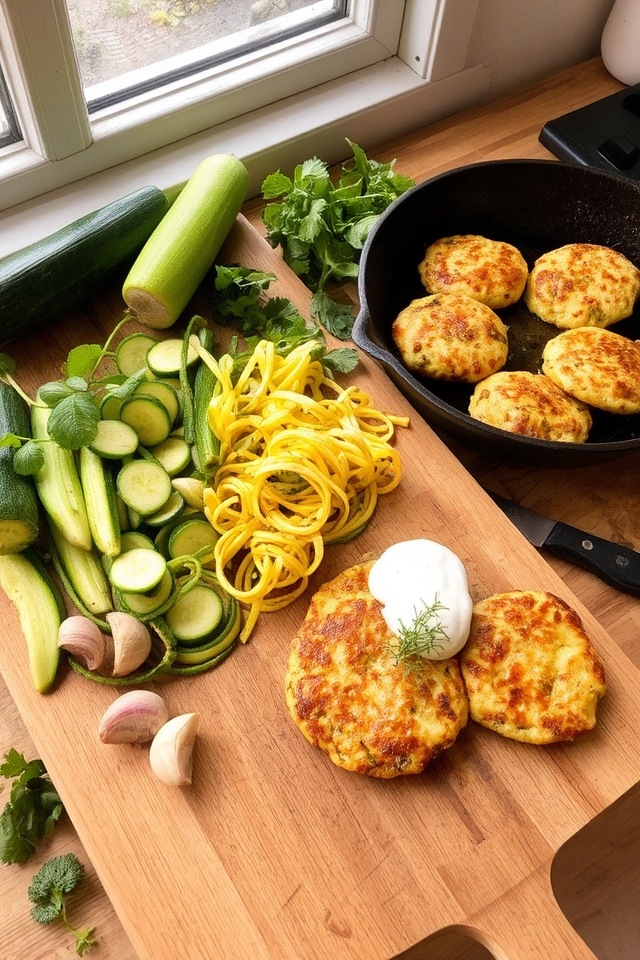
Fresh zucchini is incredibly versatile in the kitchen, allowing for a variety of delicious recipes. You can spiralize it into noodles for a healthy pasta alternative, grill it for a smoky flavor, or bake it into savory fritters. Try incorporating zucchini into ratatouille or adding it to salads for extra crunch. For a sweet treat, zucchini bread or muffins are a delightful way to enjoy this nutritious vegetable. The possibilities are endless!
Conclusion
By implementing these 22 zucchini garden ideas, you’ll watch your plants thrive like a well-tuned orchestra, each element playing its part for a bountiful summer harvest. Embrace creative techniques, from companion planting to vertical gardening, and you’ll optimize your space and resources. With careful nurturing and timely harvesting, you’ll enjoy an abundance of flavorful zucchinis ready for your kitchen. So get started, and make this gardening season the most productive yet!



